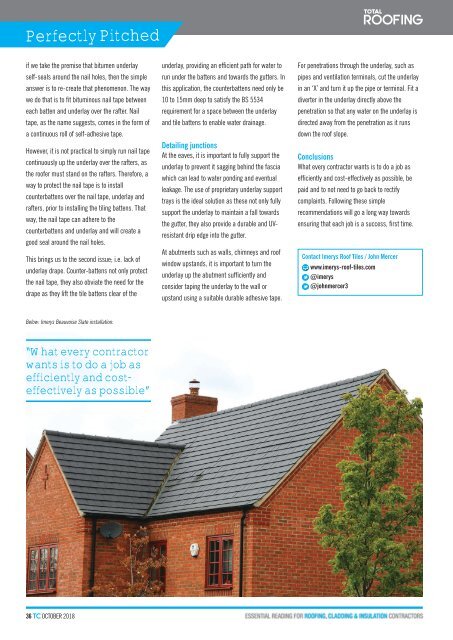October 2018
You also want an ePaper? Increase the reach of your titles
YUMPU automatically turns print PDFs into web optimized ePapers that Google loves.
Perfectly Pitched<br />
if we take the premise that bitumen underlay<br />
self-seals around the nail holes, then the simple<br />
answer is to re-create that phenomenon. The way<br />
we do that is to fit bituminous nail tape between<br />
each batten and underlay over the rafter. Nail<br />
tape, as the name suggests, comes in the form of<br />
a continuous roll of self-adhesive tape.<br />
However, it is not practical to simply run nail tape<br />
continuously up the underlay over the rafters, as<br />
the roofer must stand on the rafters. Therefore, a<br />
way to protect the nail tape is to install<br />
counterbattens over the nail tape, underlay and<br />
rafters, prior to installing the tiling battens. That<br />
way, the nail tape can adhere to the<br />
counterbattens and underlay and will create a<br />
good seal around the nail holes.<br />
This brings us to the second issue; i.e. lack of<br />
underlay drape. Counter-battens not only protect<br />
the nail tape, they also obviate the need for the<br />
drape as they lift the tile battens clear of the<br />
underlay, providing an efficient path for water to<br />
run under the battens and towards the gutters. In<br />
this application, the counterbattens need only be<br />
10 to 15mm deep to satisfy the BS 5534<br />
requirement for a space between the underlay<br />
and tile battens to enable water drainage.<br />
Detailing junctions<br />
At the eaves, it is important to fully support the<br />
underlay to prevent it sagging behind the fascia<br />
which can lead to water ponding and eventual<br />
leakage. The use of proprietary underlay support<br />
trays is the ideal solution as these not only fully<br />
support the underlay to maintain a fall towards<br />
the gutter, they also provide a durable and UVresistant<br />
drip edge into the gutter.<br />
At abutments such as walls, chimneys and roof<br />
window upstands, it is important to turn the<br />
underlay up the abutment sufficiently and<br />
consider taping the underlay to the wall or<br />
upstand using a suitable durable adhesive tape.<br />
For penetrations through the underlay, such as<br />
pipes and ventilation terminals, cut the underlay<br />
in an ‘X’ and turn it up the pipe or terminal. Fit a<br />
diverter in the underlay directly above the<br />
penetration so that any water on the underlay is<br />
directed away from the penetration as it runs<br />
down the roof slope.<br />
Conclusions<br />
What every contractor wants is to do a job as<br />
efficiently and cost-effectively as possible, be<br />
paid and to not need to go back to rectify<br />
complaints. Following these simple<br />
recommendations will go a long way towards<br />
ensuring that each job is a success, first time.<br />
Contact Imerys Roof Tiles / John Mercer<br />
www.imerys-roof-tiles.com<br />
@imerys<br />
@johnmercer3<br />
Below: Imerys Beauvoise Slate installation.<br />
“What every contractor<br />
wants is to do a job as<br />
efficiently and costeffectively<br />
as possible”<br />
36 TC OCTOBER <strong>2018</strong>

















